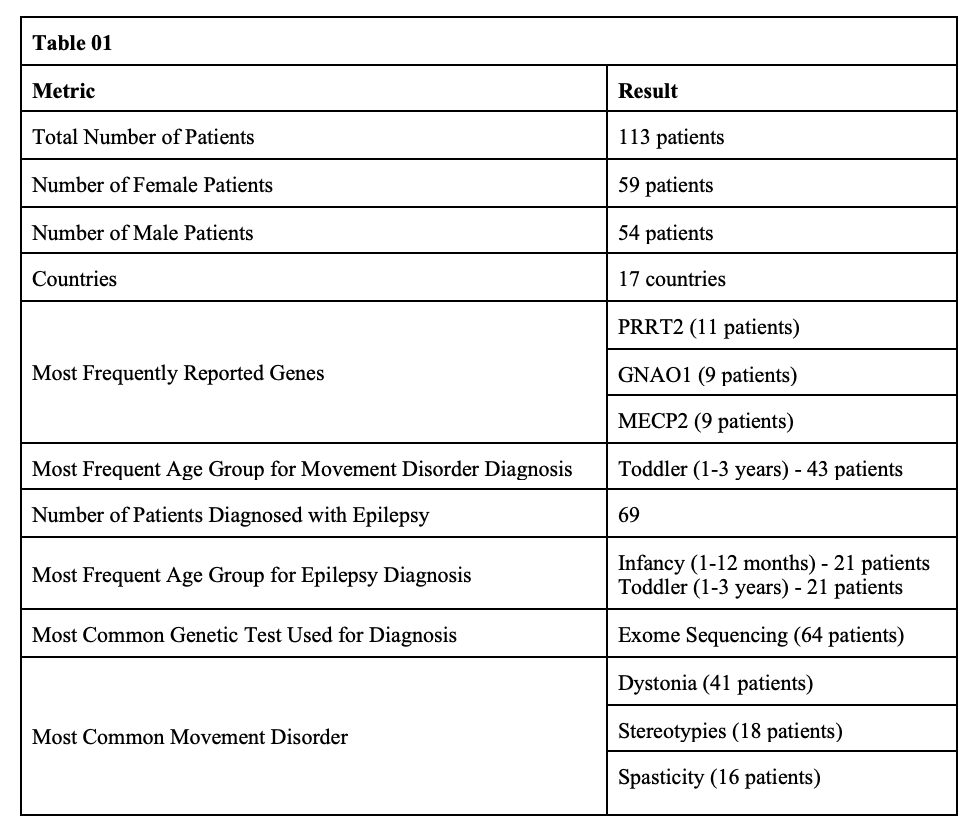Category: Pediatric Movement Disorders
Objective: To understand the spectrum and association of movement and seizure disorders on a clinical and molecular level.
Background: Epilepsy-Dyskinesia Syndromes (EDS) are neurological conditions that manifest with both movement disorders and epilepsy. These conditions are often associated with other neurological comorbidities, such as global developmental delay, hypotonia or microcephaly. Advancements in next-generation sequencing have revealed significant clinical heterogeneity and phenotypic pleiotropy, and the full spectrum of these syndromes remains to be defined.
Method: This cross-sectional multicenter retrospective study leverages data from pediatric movement disorders specialists involved in the Movement Disorders Society Pediatric Special Interest Group. We defined 102 genes of interest with a clear association of movement disorder and epilepsy in consensus. A standardized survey was designed, and data from patients who presented with a movement disorder, with or without the presence of epilepsy, was collected.
Results: 113 cases from 17 different countries were included [table 1]. Median age at last follow-up was 11.84 years (SD ± 9.23 years). Most frequently reported genes were PRRT2 (11 cases), GNAO1 (9 cases), MECP2 (9 cases), and ATP1A3 (8 cases). Most frequent age group at initial diagnosis was between 1 to 3 years (38%). Epilepsy was present in 69 cases, with the highest prevalence during infancy and toddler periods (19%). The most common phenomenologies were dystonia (36%), stereotypies (16%) and spasticity (14%). 50% of cases presented more than one phenomenology, with the most common combination being dystonia and chorea in 11/31 cases. Global developmental delay was observed in 82% and 35% presented with a Global Motor Function Classification Score of IV or V.
Conclusion: The findings of this study confirm the phenotypic pleiotropy and clinical heterogeneity of EDS, reflecting the involvement of genes crucial for brain development. Sustained efforts in this initiative will be instrumental in further understanding and characterizing these conditions, ultimately paving the way for more targeted therapeutic approaches.
Table 01 – Data Summary
To cite this abstract in AMA style:
V. Quiroz, A. Kunta, A. Tam, N. Battaglia, K. Yang, A. Pinto, L. Soliani, P. da Silva, S. Desai, M. Iype, W. Lim, J. Necpál, H. Jones, J. Pérez-Sánchez, D. Crosiers, E. Unal, R. Pons, D. Ebrahimi-Fakhari. Delineating the Molecular and Clinical Spectrum of Epilepsy-Dyskinesia Syndromes in Children (The Epilepsy-Dyskinesia Spectrum Study) [abstract]. Mov Disord. 2024; 39 (suppl 1). https://www.mdsabstracts.org/abstract/delineating-the-molecular-and-clinical-spectrum-of-epilepsy-dyskinesia-syndromes-in-children-the-epilepsy-dyskinesia-spectrum-study/. Accessed December 12, 2025.« Back to 2024 International Congress
MDS Abstracts - https://www.mdsabstracts.org/abstract/delineating-the-molecular-and-clinical-spectrum-of-epilepsy-dyskinesia-syndromes-in-children-the-epilepsy-dyskinesia-spectrum-study/

